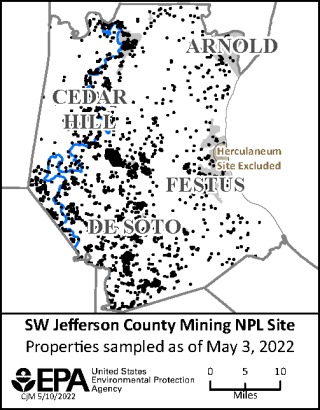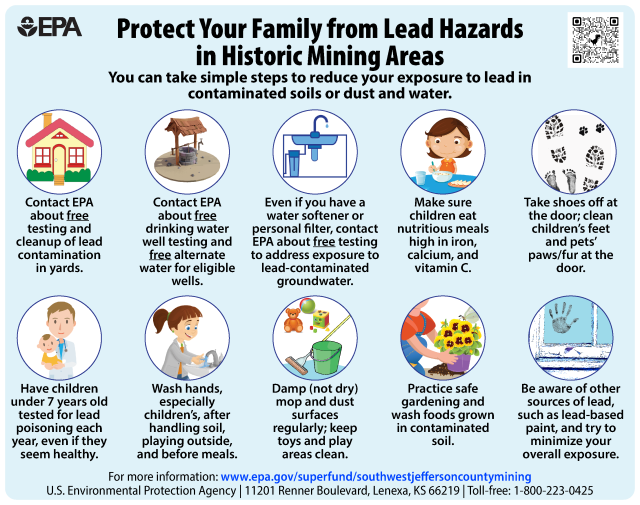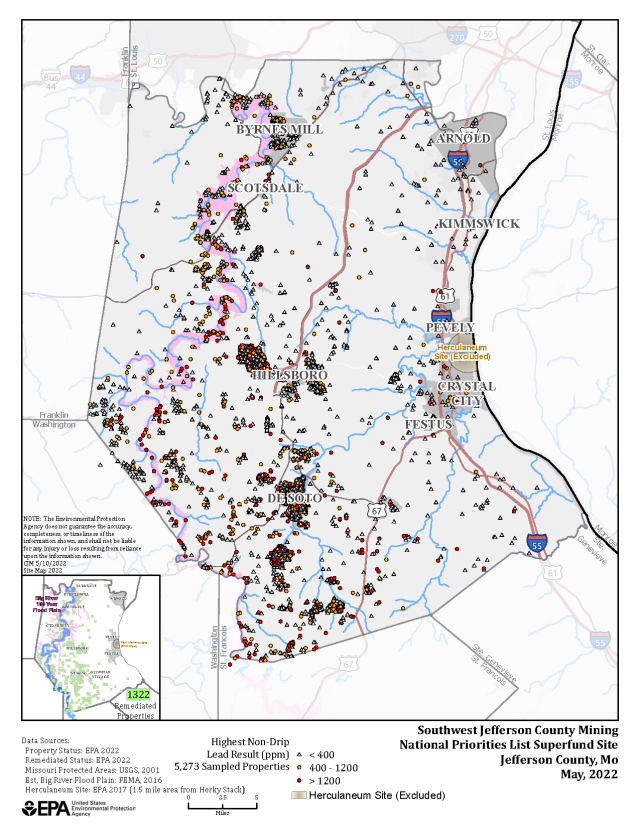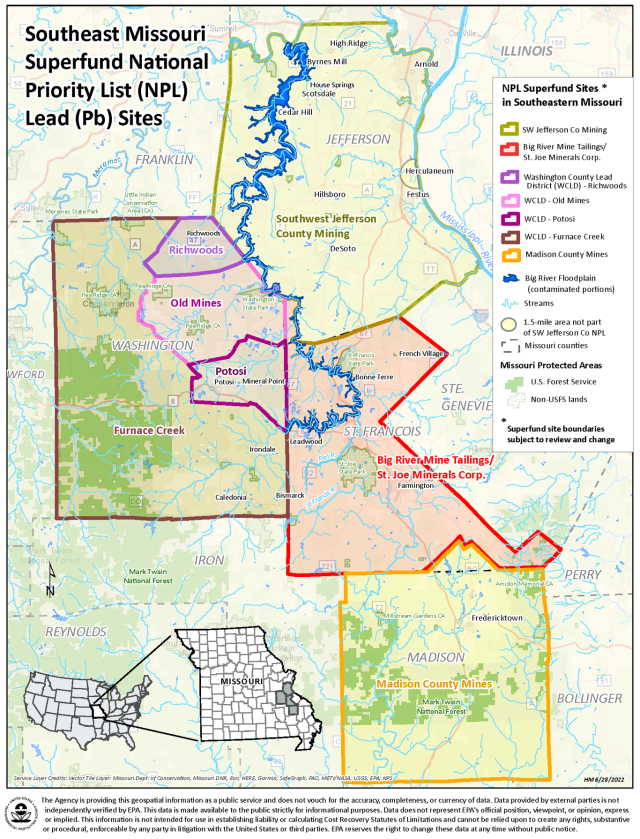Southwest Jefferson County Mining National Priorities List (NPL) Superfund Site, Jefferson County, Missouri – Fact Sheet, June 2023
Public Comment Period Extended – EPA Proposes Plan to Address Lead from Groundwater in Private, Domestic Drinking Water Wells Across Jefferson County
Opportunity for Public Input

The U.S. Environmental Protection Agency (EPA) Region 7 has extended the public comment period to submit comments on a Proposed Plan to address lead and other heavy metals contamination from groundwater in private, domestic drinking water wells at residential properties across Jefferson County. The Southwest Jefferson County Mining NPL Superfund Site covers all of Jefferson County, Missouri.
Public comments will now be accepted from Tuesday, June 20, through Friday, Aug. 4, 2023.
A Public Meeting was held Tuesday, July 11, 2023, from 6 to 8 p.m. at the Festus R-VI School District Performing Arts Center. At 6 p.m., EPA and its partners were available to talk with community members in an Open House format. At 6:30 p.m., EPA delivered a presentation about the Proposed Plan, followed by an opportunity for oral and written comments. The Jefferson County Health Department (JCHD) provided no-cost blood lead testing for children and adults during the event; talk to the JCHD about no-cost blood lead testing (636-797-3737).
Overview of EPA’s Proposed Plan

Lead is a toxic metal that is harmful if inhaled or swallowed. Lead can pose serious health risks at low concentrations, particularly to children under 7 years old, as well as those who are pregnant or nursing.
EPA’s Proposed Plan summarizes different potential approaches for how to best address contaminated groundwater in private, domestic drinking water wells across the site.
Lead is the primary contaminant of concern. The plan provides EPA’s recommended cleanup, Alternative #4: Point-of-Use (POU) Treatment Systems with Institutional Controls and Health Education. Under this cleanup alternative, residential properties at the site using private wells would be eligible for the installation of FREE POU water filtration units – if testing results find lead, cadmium, arsenic, chromium, or barium contamination above health-based limits. Residential properties also include child high-use areas such as child care facilities.
POU drinking water filtration units are also known as POU “filters.” Several types of POU filters remove lead, cadmium, arsenic, chromium, and barium from drinking water and would be provided at no cost.
The filters would need to be changed periodically (usually once a year) to properly maintain the system to meet health-based standards for drinking water; replacement filters would also be provided at no cost. For properties currently using water softeners to treat private well water: water softeners are different from POU filers. Although many water softeners remove lead and other metals, EPA recommends POU filters for added protection from lead and other heavy metals.
Also, well tests conducted by the county (for bacterial contaminants), or personal well tests mailed into the state lab do not address site hazards. If you have not had your well sampled by EPA for lead and other heavy metals, please contact EPA today. (See sampling and site maps at right.)
Contact EPA today about FREE testing of your private, domestic drinking water well and residential yard!
- To sign up, email EPA at r7-swjcmining@epa.gov
- Call EPA at 1-800-223-0425 or EPA’s contractor, Tetra Tech, at 636-797-8446.
- For more info, see Site Contact Information below.
Public Comment Period Overview

Public comments on the Proposed Plan will now be accepted for 45 days from Tuesday, June 20, through Friday, Aug. 4, 2023. Due to a timely request, the comment period was extended by an additional 15 days.
On June 20, the Proposed Plan and Administrative Record files (AR files) for this action were published online for public review on EPA's Site Profile page (click on Site Documents & Data).
How to Comment
Written comments, questions about the plan, or requests for site information can be directed to:
Elizabeth Kramer
Community Involvement Coordinator
Office of Public Affairs
U.S. EPA Region 7
11201 Renner Boulevard
Lenexa, KS 66219
Email: r7-swjcmining@epa.gov
Phone: 913-551-7186
Toll-free: 1-800-223-0425
EPA encourages community members to report any site concerns.
If you do not have internet access, you can view these documents online during normal business hours at these locations:
De Soto Public Library
712 S. Main Street
De Soto, MO 63020
636-586-3858
EPA Region 7 Records Center
11201 Renner Blvd.
Lenexa, KS 66219
1-800-223-0425
Copies of the Proposed Plan can be mailed upon request and available at the De Soto Public Library. See the related Public Notice.
About Lead and Public Health

Children under 7 years old living in this area should have annual blood tests. Talk to your pediatrician, general physician, or local health department about testing your child. It is important that children under 7 be tested annually, because lead-poisoned children do not always look or act sick. The only way to know if your children have elevated blood lead levels is to have their blood tested.
To arrange for blood lead screening, please contact one of the Jefferson County Health Department locations in these cities: Hillsboro, 405 Main Street; Arnold, 1818 Lonedell Road; or call them at 636-797-3737. Learn more on their website.
Children are more vulnerable to lead poisoning than adults because their nervous systems are still developing. Children can get lead into their bodies by putting their hands or toys in their mouths after touching lead-contaminated soil and dust. Children can be exposed to lead in their environment and before birth from lead in their mother’s body. At lower levels of exposure, lead can decrease mental development, especially learning, intelligence and behavior. Physical growth may also be decreased. A child who swallows large amounts of lead may develop anemia, severe stomachache, muscle weakness, and brain damage. Exposure to lead during pregnancy can also result in premature births.
Lead is classified by EPA as a probable human carcinogen and is a cumulative toxicant that affects multiple body systems. Some effects of lead poisoning in a child may continue into adulthood. For protection from lead poisoning, please contact EPA today about a free lead test. EPA plans to test as many residential properties as possible.
Proposed Plan Alternatives: Summary

The Proposed Plan includes summaries of cleanup alternatives evaluated for eliminating exposure to contaminated water from private, domestic drinking water wells.
Since testing began in 2004, EPA has collected water samples from 1,414 properties. Health-based limits for lead, cadmium, arsenic, or barium were exceeded at 147 properties, or 10.4% of residential properties sampled. EPA began providing bottled water to people with known contaminated wells, as part of an ongoing Superfund Removal Action. The remedial alternatives being considered in this Proposed Plan for Groundwater Wells (also known as Operable Unit 5) are:
- Alternative 1: No Action – This alternative is included to use as a baseline for comparison to other alternatives and is required by regulation; however, taking no action is not an acceptable choice.
- Alternative 2: Alternative Water Supply (Connecting to PWS or Replacement Well); Well Abandonment; Health Education; and Institutional Controls – This alternative would provide a new water source either through a connection with a nearby, existing Public Water System (PWS) or a replacement well.
- Alternative 3: Whole-House Treatment of Extracted Groundwater Using a Combination of Ion Exchange, Carbon Filtration, and Reverse Osmosis; Health Education; and Institutional Controls - Ion Exchange with Institutional Controls and Health Education – This alternative includes installing treatment systems in an entire residence, along with institutional controls and health education.
- Alternative 4: Point-of-Use Treatment of Extracted Groundwater Using Carbon Filtration or Reverse Osmosis; Health Education; and Institutional Controls – This alternative includes installing point-of-use treatment systems installed at the kitchen tap in individual residences, as well as institutional controls and health education. An additional POU unit can be provided if needed.
- Alternative 5: Alternative Water Supply (Connecting to New or Existing PWS); Well Abandonment; Health Education; and Institutional Controls – This alternative would provide all impacted private well owners with public water through connection with a nearby, existing PWS or a new community PWS, such as a rural water district. It would also provide health education and institutional controls.
Therefore, EPA’s preferred alternative is Alternative 4: Point-of-Use Treatment of Extracted Groundwater Using Carbon Filtration or Reverse Osmosis; Health Education; and Institutional Controls. Residential properties with private, domestic drinking water wells that exceed health-based standards for lead and other heavy metals (cadmium, arsenic, chromium, or barium) would be eligible for free filters and replacement filters.
Information Repository and Administrative Record Available
Site project information is available to the public at web repositories. The Administrative Record (AR) file is the official site file that contains technical documents about EPA’s response actions. EPA has developed document collections to form a clear understanding of the decisions to take actions at the site. To view the Proposed Plan, visit EPA's Site Profile page.
Next Steps

EPA Region 7 is the lead agency for this site. EPA’s support agencies are the Missouri Department of Natural Resources (MoDNR) and the Missouri Department of Health and Senior Services (MDHSS). Once EPA reviews and considers all input and information submitted during the 30-day public comment period, EPA, in consultation with MoDNR, plans to develop an Interim Record of Decision (IROD).
The IROD would include a Responsiveness Summary to summarize and address all substantive public comments received by EPA during the public comment period. EPA needs community and state acceptance of the Proposed Plan to address contamination, prior to issuing a decision. The future final cleanup decision, or Final Record of Decision (ROD), will be informed by testing results and data gathered during the IROD remedial action phase, as well as other data and analysis, to address lead contamination at the site.
For Lead and Site Information
- EPA’s Site Profile page
- EPA's Lead page
- EPA's Learn about Lead page
- CDC’s Lead page
- More information about ways to protect your family from lead hazards
- Healthy Homes fact sheets
Site Background
Technical Assistance Grant
In an effort to help affected communities understand the technical information related to a Superfund site, EPA has established a Technical Assistance Grant (TAG) Program. The program provides up to $50,000 for a qualified citizens’ group (nonprofit) to hire an independent technical advisor. The advisor can assist citizens in their interpretation of technical data, site hazards, and the different scientific technologies to support site actions.
Site Contact Information
EPA encourages community members to ask questions and report any concerns about this site. Questions, comments, requests for site information, and/or free lead testing inquiries can be submitted to EPA:
Elizabeth Kramer
Community Involvement Coordinator
U.S. EPA Region 7
11201 Renner Boulevard
Lenexa, KS 66219
Phone: 913-551-7186
Toll-free: 1-800-223-0425
Email: r7-swjcmining@epa.gov
For Free Lead Testing:
- Contact EPA’s site contractor, Tetra Tech at 636-797-8446 or r7-swjcmining@epa.gov
For Groundwater:
- Steve Sturgess, Remedial Project Manager; phone: 913-551-7913; email: sturgess.steven@epa.gov
For Residential Yards:
- Whitney Bynum, Remedial Project Manager; phone: 913-551-7735; email: bynum.whitney@epa.gov
For lead public health questions, please contact the Agency for Toxic Substances and Disease Registry (ASTDR): Cory Kokko, Regional Representative; phone: 913-217-5981; email: ckokko@cdc.gov
